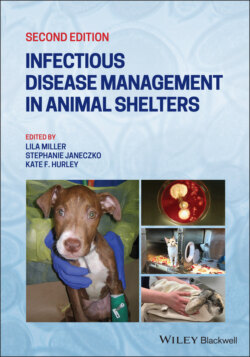Читать книгу Infectious Disease Management in Animal Shelters - Группа авторов - Страница 57
2.5.7 Periodontal/Oral Disease Prevention
ОглавлениеDental or oral health is another component of addressing wellness; it extends far beyond bad breath. Plaque and tartar buildup are known to contribute to serious health concerns ranging from oral pain to chronic, intermittent bacteremia and organ failure. Some animals with dental disease may refuse to eat because of the discomfort and pain. In dogs, periodontal disease is one of the most common health problems, affecting an estimated 80% of canine patients over the age of five years. It is especially common in small breed dogs (Debowes 1998). Periodontal disease is very common in adult cats as well, and some cats also develop resorptive lesions, which are frequently very painful (Reiter 2012).
Stomatitis (inflammation of the mouth) is another painful oral condition that predominantly affects cats, although it is occasionally seen in dogs as well. Importantly, stomatitis may be more commonly seen in cats that are housed intensively such as cats originating from hoarding situations and those housed in large group settings long term (Merck 2016). Affected cats experience wide‐spread oral inflammation around the teeth, which often extends into the back of the mouth (pharynx) and along the sides of the tongue. The exact cause is unknown; however, the vast majority of affected cats are chronic carriers of calicivirus, thus this virus may play a role in this chronic inflammatory process (Harley et al. 2011; Poulet et al. 2000). In a study of cats from large scale hoarding investigations, FCV was the most common viral respiratory pathogen detected, infecting 78% of the cats from the populations studied (Polak et al. 2014).
In an animal shelter, periodontal and oral disease prevention may be low on the list of priorities for wellness; however, it should be an important consideration for individual wellness care. When painful dental and/or oral disease is present and animals are kept for adoption or long‐term stays, a plan for timely treatment must be implemented. Adopters of animals with dental disease should be advised to seek follow‐up veterinary care as soon as possible.
In terms of simple and practical means of prevention, the use of products aimed at encouraging canine chewing activity is well recognized to be beneficial by maximizing self‐cleansing and physiological stimulation of salivary flow. Furthermore, chewing is a normal behavior for puppies and dogs, and when dogs are confined, isolated, anxious, or otherwise stressed, they may engage in chewing as a coping strategy. For these reasons, as well as to help maintain oral hygiene, dogs of all ages should be provided with a variety of safe chew toys appropriate for their size and age. For cats, preventive efforts should focus on the reduction of stress and URI since FCV has been implicated as a likely contributing cause of oral inflammation, particularly in housed cats.
